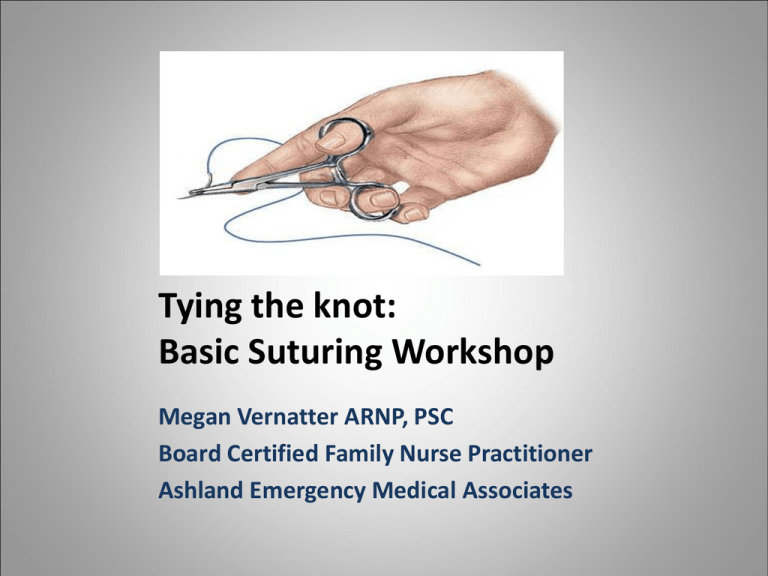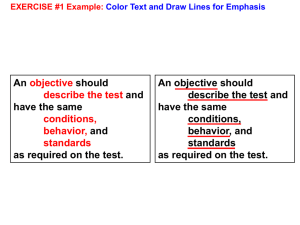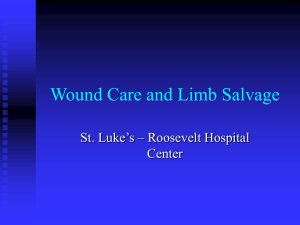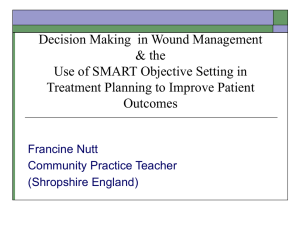
Tying the knot:
Basic Suturing Workshop
Megan Vernatter ARNP, PSC
Board Certified Family Nurse Practitioner
Ashland Emergency Medical Associates
Objectives
• Discuss the physiology of wound healing.
• Outline the appropriate history and physical exam indicated for
management of a simple wound.
• Differentiate between different types of local anesthetics based on
pharmacology, onset of action, and duration of action.
• Demonstrate administration of local anesthesia for a given wound.
• Prepare a wound for repair.
• Demonstrate various wound closure techniques- simple interrupted
sutures, vertical mattress sutures, wound adhesives, staples and
steri-strips.
• Develop a patient education plan for a repaired wound including
follow-up and suture removal.
Anatomy of the Skin and Fascia
• Comprise a complex system
of organs and anatomic
features
• Layer arrangement is most
important for wound
closure
• Layers include the
epidermis, dermis,
superficial fascia
(subcutaneous layer), and
deep fascia
Physiology of Wound Healing
Hemostasis- onset within minutes of injury, this includes vessel
vasoconstriction, platelet aggregation, the clotting cascade and
hemostatic coagulum.
Inflammatory Phase- once activated then chemotactic factors, which
attract granulocytes to the wound are released, followed by lymphocytes,
then macrophages to stimulate fibroblast reproduction and
neovascularization.
Epithelialization- epithelial cells at the stratum germinativum, or basal
layer of the epidermis, undergo morphological and functional changes.
Neovascularization- newly formed vessels replace the old injured network
and bring oxygen and nutrients to the healing wound.
Collagen Synthesis- begin to produce new collagen fibrils by day 2.
Wound Contraction and Remodeling- every wound undergoes scar
remodeling over several months.
Key Practice Points
• All lacerations produce scars.
• The function of a scar is to repair a wound with
collagen, not to restore the original appearance of
the injured tissue.
• The tensile or breaking strength of a repaired
laceration is only 5% of normal skin at the time of
suture removal.
• Final scar appearance and tensile strength are not
reached for several months.
• The appearance and size of a scar can vary according
to the mechanism of injury, anatomic location,
wound infection, poor technique, and other factors.
Key Practice Points continued
• Visibly embedded grit in the epidermis must be
removed to prevent permanent tattooing.
• Sutures can produce permanent marks in the skin if
left longer than 7-14 days.
• Some people can react to wounds by producing
excessive, hypertrophic, or keloid, scars.
• There are no chemical or surgical methods to
eliminate scars.
• Current research using growth factors has shown
that regeneration of injured tissue, rather than
collagen deposition, may be possible in the future.
Cosmetic Outcome
Keloid scarring
Chicks dig scars
Risks in Wound Care
• Wounds account for >10 million ED visits a yr
• >25% of closed malpractice claims involve
wound care
• 5% of wounds become infected
• Retained foreign bodies are the top reason for
lawsuits related to wound care
• Treatment Goals: avoid infection and achieve
acceptable scar
Patient Safety and Comfort
. Obtain a history including the mechanism and timing of
•
•
•
•
•
•
the injury
Obtain a health, medication and allergy history
Verify and update tetanus status
Inform patient of procedure including description of
anesthesia to be used, type of closure, wound care and
follow up
Address any patient/family questions or concerns
Discuss family/parent presence during procedure
Obtain facility appropriate consent for procedure
Positioning
• Try to optimize patient and care giver comfort
• Patient laying on stretcher
• Caregiver sitting or adjust stretcher height to
avoid straining
• Use bedside trays or tables for hand wounds
• Utilize over head or portable lighting
• Position equipment for easy access
• Have holding assistance or utilize immobilization
if appropriate
Wound Examination
•
•
•
•
•
•
•
•
Perform a thorough wound examination
Inspect and Document wound:
Location
Size ( length, width and depth )
Appearance ( linear, jagged, flapped )
Condition ( clean, contaminated, active bleeding)
Note any visible foreign bodies or tendon injury
Neurovascular and functional status
Indications for Consultation
• Human or Animal Bite
• Grossly contaminated wound, difficulty controlling
bleeding or foreign body noted
• Wounds greater than 18 hours old
• Open fracture or tendon injury
• Vermilion border repair- (1mm of misalignment can
cause devastating cosmetic defect)
• Eye lid, nose, complex facial or oral lacerations
• Nail bed repair
• If in doubt consult plastics, oral or general surgeon
before wound closure
Local Anesthetic Options
Esters
. cocaine - (rarely used)
. procaine- (eg, Novocain)
. benzocaine
. tetracaine
. chloroprocaine
Amides
• lidocaine
• mepivacaine
• bupivacaine
• prilocaine
• lidocaine with epi – DO NOT
USE ON TIPS OF
APPENDAGES
• Mixing lidocaine and
bupivacaine has no benefit
Local Anesthetics
Agent
Percent
Infiltration
Block (min)
Duration
Max Dose
lidocaine
1% - 2%
immediate
4-10
30-120 min
4.5mg/kg
lidocaine
w/epi
1%
immediate
4-10
60-240 min
7mg/kg
mepivacaine 1% - 2%
immediate
6-10
90-180 min
5mg/kg
bupivacaine
slower
8-12
240-480 min 3mg/kg
topical
0.25% -0.5%
5-15 min
20-30 min
2-5 ml
Local Anesthetic Allergy
•
•
•
•
•
•
True allergic response in <1% of patients
Rarely allergic to esters and amides
Alternatives :
No anesthetic for small wounds (< 3 sutures)
Ice placed directly over the wound
Use of preservative free spinal, epidural, and intravenous
anesthesia
• Local infiltration with diphenhydramine 50 mg /1 ml
diluted in 4 ml of normal saline is sufficient for 20 – 30
minutes of anesthesia (except for facial wounds) then use
topical anesthetics
Topical Anesthetics
LET
• Combination of lidocaine,
epinephrine, and tetracaine
• Effective 15 – 20 minutes
after application
• Use a cotton ball to apply
• Use a glove or tape to
secure over wound
• Effective on face and body
• Avoid tips of appendages
TAC
• Combination of tetracaine,
adrenaline, and cocaine
• NOT Approved by FDA
• Must be mixed by
pharmacist
• Expensive
• Contraindicated on or near
mucosal surfaces
• NOT recommended by
speaker
Topical Sprays
• Gebauer’s Pain Ease ©is an instant topical
anesthetic skin refrigerant approved to
temporarily control the pain associated with
needle procedures or minor surgical
procedures.
• It can be applied to minor open wounds and
intact oral mucous membranes.
• It is non-drug, non-flammable and can be
used by any licensed healthcare practitioner
without the order of a physician.
Risk and Safety Information
•
•
•
•
•
•
•
•
•
Published clinical trials support the use in children > 3 years of age
Do Not use on large wounds, puncture wounds or animal bites
Do Not spray in eyes
Overspraying may cause frostbite
Freezing may alter skin pigmentation
Use caution on diabetics or those with poor circulation
Apply only to intact oral mucous membranes
Do Not use on genital mucous membranes
The thawing process may be painful and freezing may lower resistance to
infection and delay healing
• If skin irritation develops, discontinue use
• Rx only
• © Gebauer Company 2012
Technique for Wound Infiltration
Direct Technique
• Insert 25,27 or 30G ½- 1 ¼”
needle through open
wound into superficial
fascia parallel to and just
deep to dermis
• Inject a small bolus of
anesthetic into wound
margin and repeat at
adjacent margin until all
edges and corners are
anesthetized (approx 3 to
5 ml for a 3-4 cm wound)
Technique for Wound Infiltration
Parallel Margin (Field Block)
• Need at least 25G 1 ¼ - 2”
needle
• Insert at one end of the
wound and slowly inject a
“track” of anesthetic
• Reinsert needle at distal
end of first track and repeat
on all sides until complete
infiltration has been
achieved
Reducing Pain of Local Anesthetics
• Buffering each 10 ml of lidocaine with 1 ml of
standard bicarbonate solution significantly reduces
pain of injection
• Selecting smallest needle size decreases pain and
patient anxiety
• Injecting slowly helps to decrease soft tissue
expansion which stimulates pain receptors
• Injecting into wound edges rather than surrounding
wound hurts less and does not increase risk of
infection
• Waiting >2 minutes to allow anesthetic to take effect
before cleansing wound allows for better results
Wound Cleansing
• NEVER put anything into wound that you would
not put in your own eye
• Choice of antiseptic- in studies only 0.001%
solution of povidone-iodine bacteriostatic
without harming fibroblasts
• Avoid povidone-iodine scrub formulation which
contains ionic detergent and increases infection
when used on fresh wounds
• Soaking in normal saline Does Not aid healing
and increases bacterial count
Wound Irrigation
•
•
•
•
Decreases bacterial load
Relatively high pressure does not force bacteria into tissue
Use a mask, shield or splatter guard
Current practice is the use of a 35ml syringe with 19G
catheter (develops 7-8 psi effective in reducing debris and
bacterial contaminates)
• Avoid high powered 50-70 psi pulsatile lavage systems that
can dissect wound margins
• Studies show no difference in wound infection rates
comparing saline and running tap water
• Volume varies between 100-250 ml or more for
contaminated wounds
Wound Hair Removal
• Close shaving causes microtrauma that acts as
a portal for bacterial invasion
• Clipping hair around the wound with scissors
is recommended
• Hair or clippings that are inadvertently buried
in wounds can result in infection
• Hair can be cleansed with standard techniques
and solutions
NEVER SHAVE AN EYEBROW – Hair growth is
inconsistent
Time frame for Wound Closure
. “Golden period”- because wounds are often contaminated
with bacteria, there is a time limit between the laceration
and closure. It varies between 6 hours (hand and feet) and
24 hours for the vascular face.
.Primary closure- fresh wounds may be sutured up to 18 hours
after injury and clean wounds may be sutured up to 4 days
later
. Secondary closure – for grossly contaminated wounds
debridement is critical for preventing infection and are then
allowed to heal gradually without suturing
. Delayed primary closure – wound is cleansed, debrided, and
observed for 96 hours then closed if infection does not
develop
Methods for repair of simple
wounds
•
•
•
•
Tissue adhesives
Wound taping
Wound stapling
Suturing
Indications for Tissue Adhesives
• Fresh lacerations that are within the “golden
period”
• Lacerations under low tension that are easy to
approximate
• Lacerations with clean and even edges that
can be closed with no gaps
• Lacerations with little or no blood oozing
• Situations in which adhesive runoff can be
controlled or avoided
Adhesive Wound Closure Technique
• Pat the wound dry after cleansing, debridement and bleeding has been
controlled
• To decreased runoff, position the patient so that the wound is facing up
(use Trendelenburg or reverse Trendelenburg for wounds around the eye).
Apply a rim of petroleum ointment around the wound and hold a gauze
sponge to remove excessive adhesive quickly
• Crush the plastic applicator and squeeze until adhesive covers the
applicator tip
• The wound is then gently approximated with fingers or forceps
• Adhesive is layered over the wound with a margin of 5-10 mm. Finger or
forceps approximation is maintained for 30-60 seconds to allow for
polymerization
• After 15-20 seconds, another layer may be applied and 3 layers are
recommended to complete the closure
• It takes 2.5 minutes for adhesive to reach its full tensile strength
Adhesive Closure Aftercare
• Instruct the patient to keep the wound clean
and dry for 24 hours
• After 24 hours may gently cleanse wound
using caution not to disrupt the closure
• If a wound dehisces, instruct the patient to
return for delayed primary closure with
wound tapes or sutures
• No follow-up is needed for glue removal as it
peels off on its own or with epidermal
sloughing
Demonstration of Wound Closure
with Adhesive
Skin tear before repair
After adhesive repair
Indications for Wound Taping
• Superficial, straight lacerations under little tension. Suitable
area include: forehead, chin, malar eminence, thorax, and
nonjoint areas of extremities
• Flaps in which sutures might compromise vascular perfusion
at the wound edges
• Lacerations with a greater-than-usual potential for infection
• Lacerations in an elderly or steroid-dependent patient who
has thin, fragile skin
• Support for lacerations after suture removal
• Tapes do not work well on irregular wounds, wounds with
active bleeding or secretions, intertriginous areas, scalp and
joint surfaces
Technique for Wound Taping
• The wound is cleansed, irrigated, and debrided prn. Hemostasis has to be
complete and the surface completely dried.
• Skin adhesive is applied to the surrounding skin to increase adhesion.
• Tapes are cut to the desired length while they are still on the backing
sheet. Usually allow a 2-3 cm overlap on each side of the wound.
• One of the perforated end tabs is gently removed to prevent deforming of
the tape ends.
• Individual tapes are removed from the backing with forceps by pulling
directly away from the backing.
• ½ of the tape is securely placed on one side of the midportion of the
wound and is held securely. The opposite wound edge is apposed with a
finger of the opposite hand. After edge apposition, the tape is completely
secured.
• Further tapes are placed evenly adjacent to the original midwound tape,
and repeat until edges are completely apposed leaving a 2-3 mm gap
between tapes.
• The final step is to place cross stays to prevent elevation of ends and
wound tension.
Wound Taping Aftercare
• Tapes are maintained in place for at least as
long as sutures would be for the anatomic
area.
• A taped wound cannot be washed or
moistened.
• Tapes should NEVER be wrapped around a
digit circumferentially, because of constriction.
Demonstration of Wound Closure
with Taping
Indications for Stapling
• Linear, sharp (shearing mechanism) laceration
of the scalp, trunk, and extremities.
• Is NOT recommended for hands or face.
• Temporary, rapid closure of extensive
superficial lacerations in patients requiring
immediate surgery for life-threatening
trauma.
• Avoid in anatomic areas where studies such as
CT or MRI are anticipated to avoid streak
artifact.
Stapling Technique
• Forceps are used to evert the wound edges
• Before triggering, the stapler should be placed
gently on the skin over the wound without
indenting the skin
• The trigger is squeezed gently and evenly to
advance the staple into the tissue
• Once placed a space should be visible
between it and the skin
• The stapler is then “backed out” to disengage
Staple Aftercare
• Staples are kept in place for the same length
of time as sutures in similar anatomic sites.
• Staple removal requires a special device that is
provided by each manufacturer.
• The lower jaw is placed under the crossbar of
the staple, and the upper jaw is closed to
open the loop of the staple.
Demonstration of Wound Closure
with Stapling
Suturing Equipment
• Mask, eye wear or face shield
• Gloves- protect the clinician not the patient,
some studies recommend non-sterile gloves
• Sutures – wound specific (see suggestions)
• Suture kit – most are disposable and should
include needle holders, forceps, scissors, and
hemostats
• Dressing supplies- wound specific (most facial
lacerations may be left uncovered)
Suggested Guideline for Suture Selection
Body Region
Percutaneous
Deep
Scalp
5-0/4-0 monofilament
4-0 absorbable
Ear
6-0 monofilament
Eyelid
7-0/6-0 monofilament
Eyebrow
6-0/5-0 monofilament
5-0 absorbable
Nose
6-0 monofilament
5-0 absorbable
Lip
6-0 monofilament
5-0 absorbable
Oral mucosa
5-0 absorbable
Face/Forehead
6-0 monofilament
5-0 absorbable
Trunk
5-0/4-0 monofilament
3-0 absorbable
Extremities
5-0/4-0 monofilament
4-0 absorbable
Hand
5-0 monofilament
5-0 absorbable
Foot/sole
4-0/3-0 monofilament
4-0 absorbable
Penis
5-0 monofilament
Post Procedure
• Assess for symmetry, wound appearance and
tension on suture line
• Now is the time to remove and replace any
suture if you are not satisfied with the result
• Re-evaluate neurovascular and functional status
• Re-enforce Wound Care and Discharge
Instructions
• Reassure patient that oral antibiotics are not
needed unless develop signs of infection
Wound Care Instructions
• May remove dressing and inspect wound in 24 hours
• Use a clean cloth to gently cleanse wound with soap
and water one to three times a day
• May apply topical antibacterial ointment to prevent
dressing from sticking, but does not decrease infection
rate
• Re-dress with gauze or bandaid as needed to protect
wound, keep it clean and the dressing dry
• Avoid swimming for 24 hours
• Return for increased redness, swelling, or drainage of
wound, pain or fever uncontrolled with acetaminophen
or ibuprofen
Recommended Intervals for Suture
Removal
Location
Days to Removal
Scalp
6-8
Face
4-5
Ear
4-5
Chest/abdomen
8-10
Back
12-14
Arm/leg
8-10
Hand
8-10
Fingertip
10-12
Foot
12-14
For joint extensor surfaces
Add 2-3 days to above
Sample Documentation
• Wound cleansed with betadine & irrigated with saline then
prepped & draped in sterile fashion. Anesthetized with 3 cc of
2% lidocaine. Wound probed with no visible foreign bodies,
no tendon injury noted. Wound edges re-approximated with
(6 ) 5-0 sutures in a simple interrupted percutaneous fashion.
Antibacterial ointment & dressing applied.
• Tolerated procedure well.
• Neurovasular and functional status intact post procedure.
• Verbalized understanding of wound care and instructions.
Agrees to return in 10 days for suture removal.
Summary of the Goals of Wound
Closure
• Hemostatis- all bleeding except oozing should
be controlled before wound closure
• Anesthesia- to effectively control pain, and
allow for adequate wound cleansing
• Irrigation- is the most important step in
reducing potential for infection
• Wound exploration- xray and functional test
do not always identify foreign bodies or
tendon injuries
Goals of Wound Closure
• Removal of devitalized and contaminated
tissue
• Tissue preservation – to prevent a permanent,
uncorrectable, unsightly scar (all wounds scar)
• Closure tension- excessive wound constriction
strangulates tissue, leading to a poor outcome
• Deep sutures- act as a foreign body and
should use as few as possible
Goals of Wound Closure
• Tissue handling- rough handling with forceps
can cause tissue necrosis
• Wound infection- antibiotics are no substitute
for wound preparation and irrigation
• Dressings- properly applied assist in wound
healing
• Follow-up- well understood verbal and written
instructions for wound care, follow-up and
suture removal are essential to complete care
Demonstration of Wound Closure
with Suturing
Simple interrupted suture
Vertical mattress sutures
Questions & Answers
Demonstration & Return
Demonstration
References
• Greenberg, MI et al: Text-atlas of emergency
medicine. Wound care 19:675-697, 2005
• Lex, JR: Wound management. Audio Digest
26:04, 2009
• Trott, AT: Wounds and lacerations, emergency
care and closure. Saunders, Fourth edition.
2012
• Johnson & Johnson Wound closure manual,
2005









